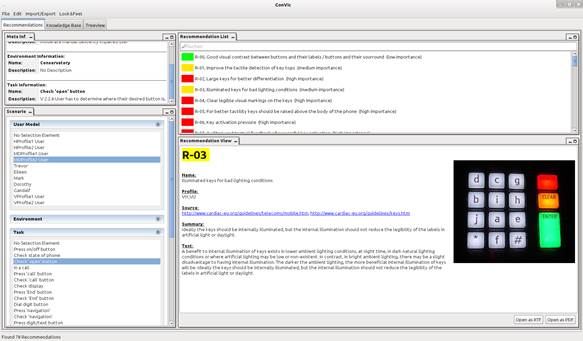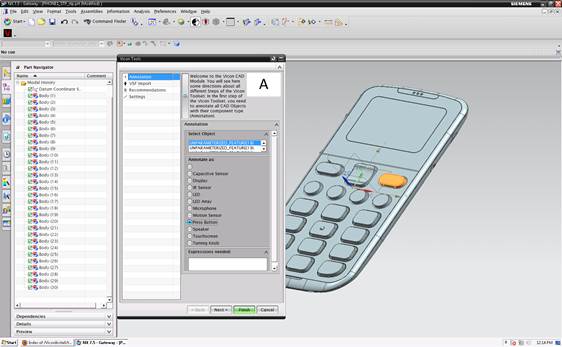Application of abstract user models as customer involvement in product development
- Markus Modzelewski. University of Bremen, modze@cs.uni-bremen.de
- Michael Lawo. University of Bremen, mlawo@cs.uni-bremen.de
- Yehya Mohamad, Fraunhofer FIT, yehya.mohamad@fit.fraunhofer.de
- Svetlana Matiouk, Fraunhofer FIT, svetlana.matiouk@fit.fraunhofer.de
1. Problem Description
One challenge of recent product development is the inclusion of customer-oriented needs in product design addressing an as wide group of population as possible (Langdon and Thimbleby, 2010). Existing methods of user involvement range between „Design for-” and “Design by-” approaches (Kaulio, 1998). This submission focuses on the modification of Quality Function Deployment (Akao, 2004) by including recommendations based on customer needs as a framework for designers addressing people with age related mild to moderate disabilities. We tested this approach using an abstract user model on user interfaces for washing machines and mobile phones as end products. Designers specify in our approach a typical scenario to obtain suggestions and recommendations (Consortium, 2012; P. Kirisci et al., 2011; Lawo et al., 2011) that were extracted from different sources as published user studies or knowledge of designers and standards (Abbott, 2007).
2. Background
Kaulio presented a review on selected methods of user involvement and compared 7 different methods (see Kaulio, 1998). Quality function deployment (Akao, 2004) describes an analytical approach for first design phases with involvement of end users by extraction of consumer demands into quality characteristics. User-oriented product development (Rosenblad-Wallin, 1985) focuses upon the involvement after first prototype generation. Concept testing (Moore, 1982) uses first sketches in an evaluation with customers. Beta testing (Fine, 2002) refers to prototype evaluation with customers. Customer-idealized design (Ciccantelli and Magidson, 1993) involves customers by transferring product design into a group exercise. Lead user method (Herstatt and Von Hippel, 1992) lets single representatives of a target group solve design problems and issues. Participatory ergonomics (Sundin et al., 2004) involves different groups of product development into the process. Eventually all 7 methods have pros and cons for physical end products, according to the level of involvement (Design for-, with-, and by-) but also to the creativity of design and technological advancement.
3. Approach
To support designers throughout the design process, context awareness of end users is necessary. A user study was conducted with disabled and elderly customers of end products to define situations and issues of the interaction with virtual prototypes. From this, abstract user models with hearing, visual and manual dexterity disabilities were elicited (P. T. Kirisci et al., 2011). The attributes (e.g. visual acuity) were used to define personas, environments and tasks associated to extracted recommendations. Designers may choose typical scenarios of use for their product by selecting one or more personas, typical environments in which the product should be used and typical tasks performed with the product. Each selection infers a set of recommendations unified in the result. The Recommender was implemented for the first design phase of product development (Sketch phase) as a standalone tool as presented in Figure 1.

Figure 1: Output of recommendations (right) based on scenario selection (left) in the sketch design tool
For the next phase of CAD design the recommender was implemented as an integrated module of the PLM software Siemens NX (see Figure 2). Designers get in this phase recommendations for their previous scenario selection but also a set of recommendations inferred from a semantic annotation of virtual objects. In the last recommender supported stage designers can test the virtual prototype in a virtual environment with avatars of the persona. The avatar executes the tasks of the selected scenario. The result is an output of issues of the designed product.
The application of the approach in a complete product development process aims to manipulate and extend the method of quality function deployment for a more specialized and iterative solution. Designers get recommendations for more accurate and context aware customer products before any prototype has been produced.

Figure 2: Integrated module in Siemens NX
4. Challenges
Our approach addresses designers as the end users of the software as well as the end users of the product. In the VICON project the usual product development process of products for elderly people was studied for improvements in terms of efficiency and contextual awareness of customers but also for a wider range of customers. The framework has to be included without hindrance to designers. As design is a creative process, it must not restrain capabilities. Also the validity of each model, especially regarding user model and recommendations must be approached.
5. Outcomes
The user study with disabled end users of products resulted in an ontology, including preferences and abstract attributes. Single representative individuals were implemented to define end users for different scenarios. In addition, rules were implemented to infer all individual representatives into impairment groups. For instance the rule: “greaterThan (?hearing500hz, 20) , greaterThan (?hearing1khz, 25), greaterThan (?hearing2khz,30), greaterThan (?hearing4khz,40), greaterThan (?backgroundnoise,100) -> (?x rdf:type Vicon:HProfile1)” uses different parameters of user models to define single personas as members of the group “HProfile1” which is the group of mild visual impaired customers[1].
Regarding the user study with designers, the majority of participants in a designer study use quality function deployment as their standard method for customer involvement during product development process (29.4%). Concept testing was used by 20.6% and Beta testing by 17.6%. Regarding the framework we got mainly positive feedback and remarks for improvements (Consortium, 2013a). The evaluation on customer side was conducted using mock-ups of washing machine panels and mobile phones. A comparison between existing user interfaces and emerged user interfaces was used to identify problematic issues. Regarding mobile phones the feedback was positive due to changes such as bigger buttons. For washing machine panels one issue was solved regarding more spacing between buttons, but this resulted in a smaller knob due to less available space as draw-back (Consortium, 2013b).
6. Future Research
The feedback of the studies with designers and end customers of products will be integrated into the framework. Due to feedback of designers, especially usability of the software will be improved. Also, as stated in the results of the customer study, the format and content of each recommendation will be improved significantly for more content including pictures with examples explaining issues more purposefully.
References
- Abbott, C., 2007. tiresias. org Information resource for people working in the field of visual disabilities. J. Assist. Technol. 1, 58–59.
- Akao, Y., 2004. Quality function deployment: integrating customer requirements into product design. Productivity Press.
- Ciccantelli, S., Magidson, J., 1993. From experience: consumer idealized design: involving consumers in the product development process. J. Prod. Innov. Manag. 10, 341–347.
- Consortium, V., 2012. Virtual User Model (Final release).
- Consortium, V., 2013a. Deliverable 4.3 - Evaluation report on how convenient it is to use Virtual User Model and adapted prototype.
- Consortium, V., 2013b. Deliverable 4.4 - Focus Group Report.
- Fine, M.R., 2002. Beta testing for better software. Wiley.
- Herstatt, C., Von Hippel, E., 1992. From experience: Developing new product concepts via the lead user method: A case study in a “low-Tech” field. J. Prod. Innov. Manag. 9, 213–221.
- Kaulio, M.A., 1998. Customer, consumer and user involvement in product development: A framework and a review of selected methods. Total Qual. Manag. 9, 141–149.
- Kirisci, P., Klein, P., Modzelewski, M., Lawo, M., Mohamad, Y., Fiddian, T., Bowden, C., Fennell, A., Connor, J., 2011. Supporting inclusive design of user interfaces with a virtual user model. Univers. Access Hum.-Comput. Interact. Users Divers. 69–78.
- Kirisci, P.T., Thoben, K.D., Klein, P., Modzelewski, M., 2011. Supporting inclusive product design with virtual user models at the early stages of product development, in: Proceedings of the 18th International Conference on Engineering Design (ICED11), Vol. 9. pp. 80–90.
- Langdon, P., Thimbleby, H., 2010. Inclusion and interaction: Designing interaction for inclusive populations. Interact. Comput. 22, 439–448.
- Lawo, M., Kirisci, P., Modzelewski, M., O’Connor, J., Fennell, A., Fiddian, T., Gökmen, H., Klann, M., Geissler, M., Matiouk, S., Mohamad, Y., 2011. Virtual User Models – Approach and first results of the VICON project. Echallenges E-2011 Conf. Proc.
- Moore, W.L., 1982. Concept testing. J. Bus. Res. 10, 279 – 294.
- Rosenblad-Wallin, E., 1985. User-oriented product development applied to functional clothing design. Appl. Ergon. 16, 279–287.
- Sundin, A., Christmansson, M., Larsson, M., 2004. A different perspective in participatory ergonomics in product development improves assembly work in the automotive industry. Int. J. Ind. Ergon. 33, 1–14.
[1] The complete software including initial ontology and ruleset is available at https://sourceforge.net/projects/convic/